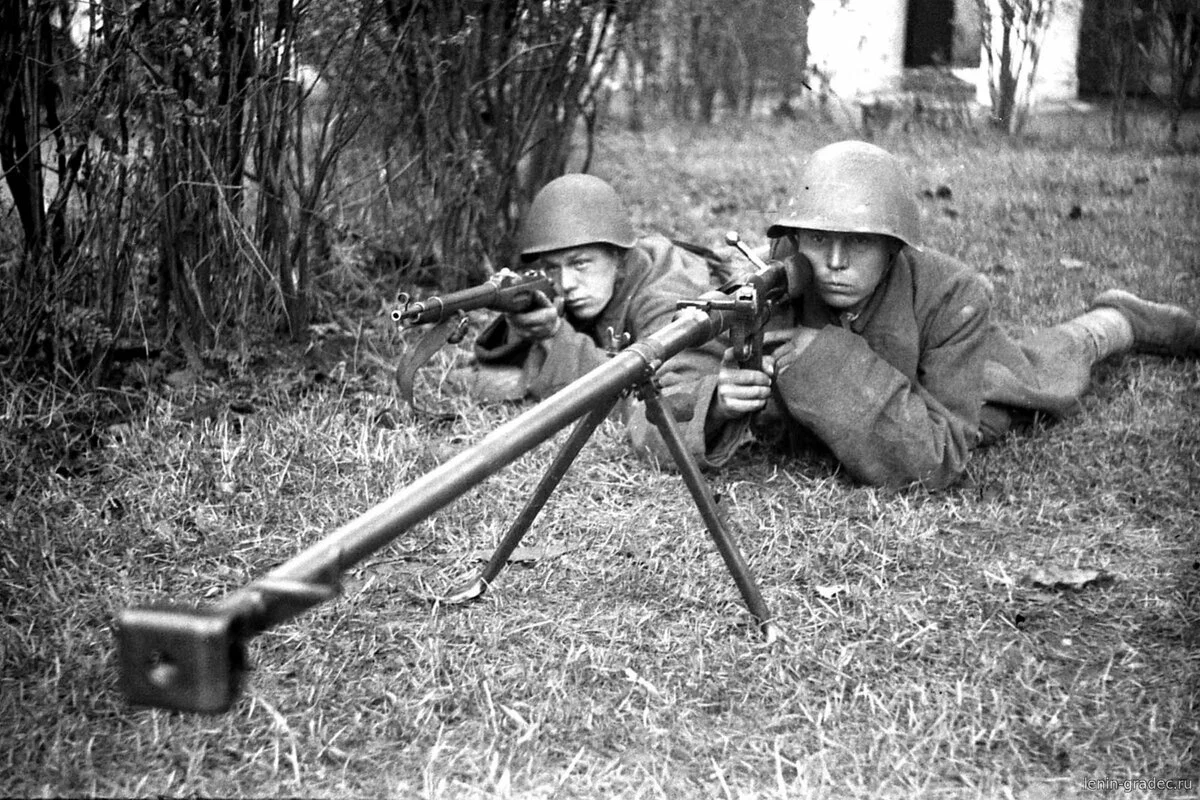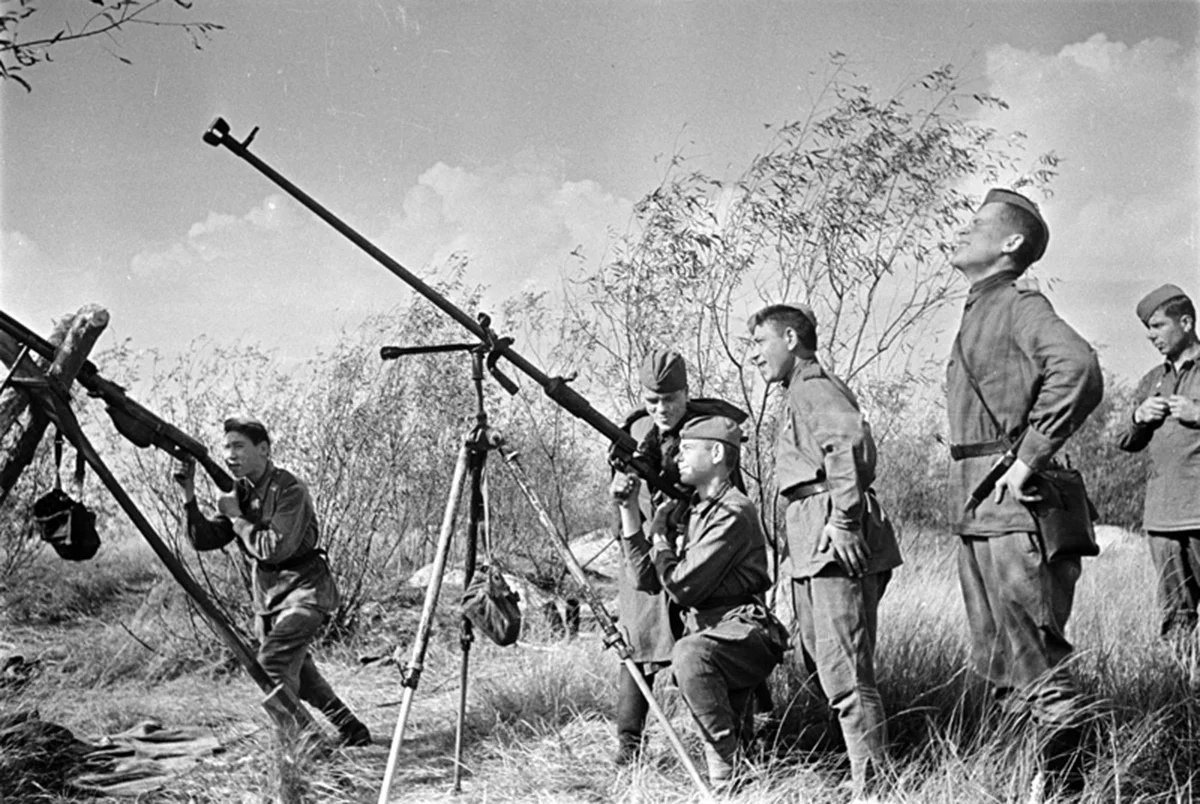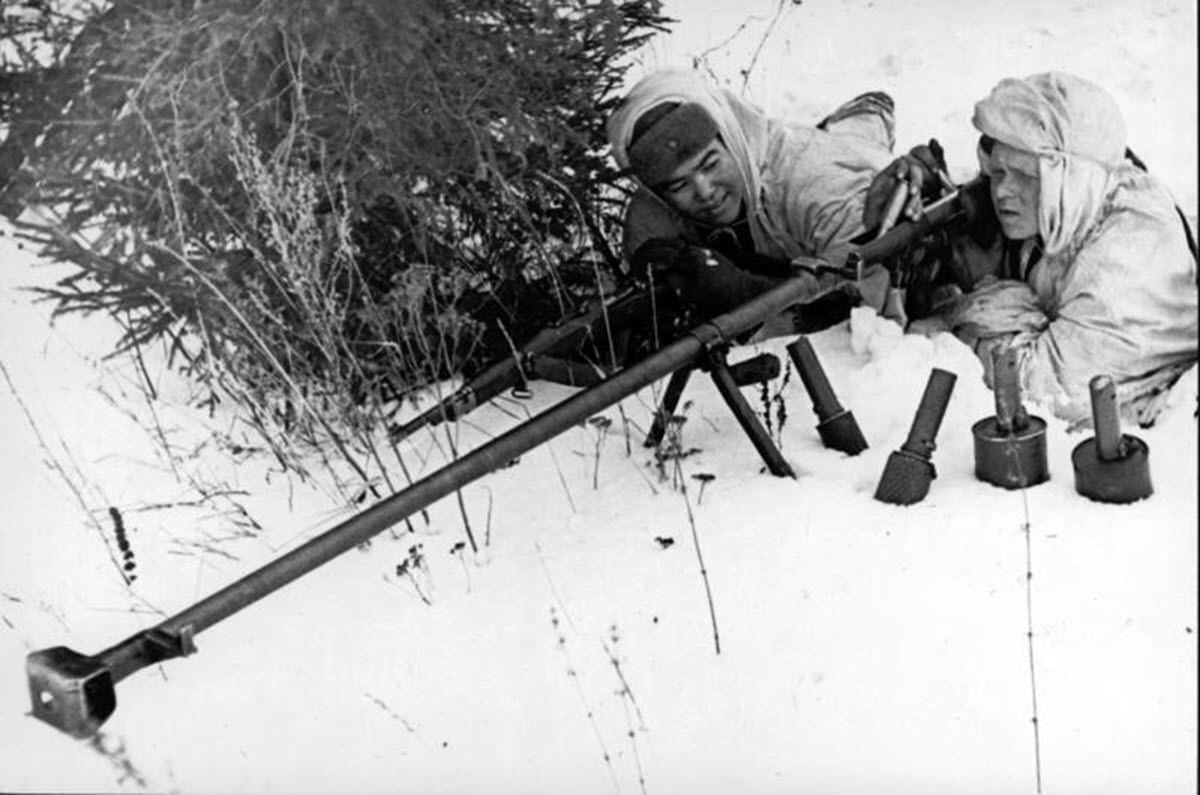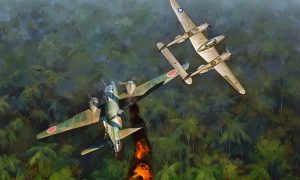PTRD-41 – Anti-tank single-shot rifle of the 1941 model of the Degtyarev system (PTRD) — Soviet anti-tank gun, developed by the group of A. A. Dementiev in the Degtyarev Design Bureau and put into service USSR Armed Forces August 29, 1941.
Designed to fight average and light tanks and armored vehicles at distances up to 500 meters. Also, a gun could be fired at weaker points such as sight slots and firing points, covered with armor, at distances up to 800 m and aircraft at distances up to 500 m.
Content
1 Previous events
2 History
3 Combat use
4 Characteristics
5 Construction
6 Ammunition
7 Operating countries
History of PTRD
The first work on the creation of anti-tank rifles in the USSR began in the early 1930s, in the second half of the 1930s they were intensified. On March 13, 1936, a competition was announced for the design of anti-tank rifles of 20-25 mm caliber and weighing up to 35 kg.
After analyzing the results of the 1936-1938 competition, the Artillery Committee Main Artillery Directorate of the Red Army in November 1938, he developed the basic criteria for an anti-tank rifle that meets the requirements of modern mobile combat. Further work on the creation of PTR was slowed down by the lack of a suitable cartridge, but already in 1938 the first sample of a 14.5 mm cartridge was developed.
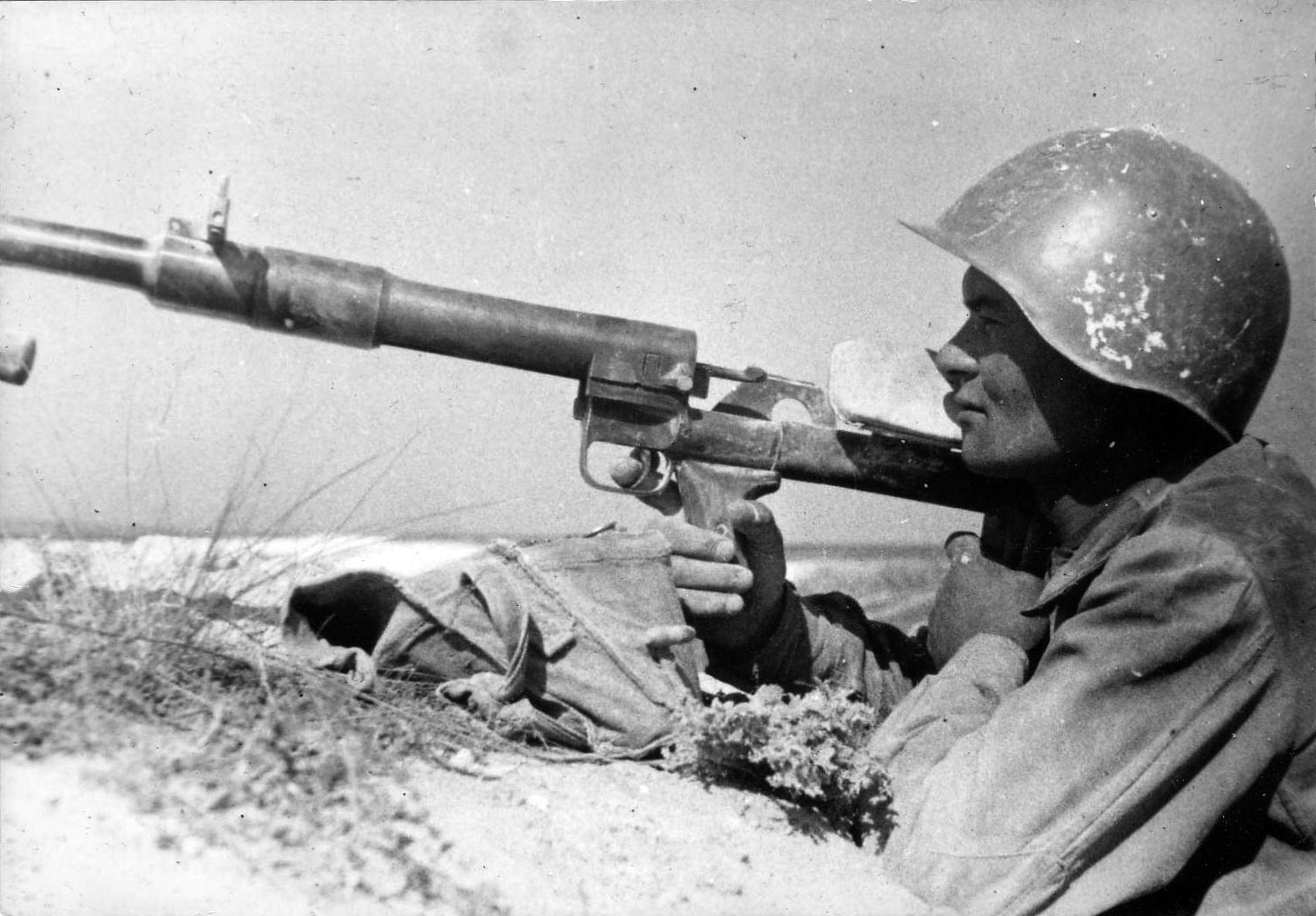 In 1939, tests began on 14.5 mm PTR system Rukavishnikov, simultaneously with which in 1939-1940. work continued on the 14.5 mm cartridge. However, the attitude towards PTR among the military was ambiguous; in 1940, the leadership of the USSR People’s Commissariat of Defense was of the opinion that enemy tanks would have armor with a thickness of at least 60-80 mm. As the initial stage of the war showed, the enemy was still using light and medium tanks that did not reach such armor, moreover, there was an acute shortage of light and mobile anti-tank weapons in the rifle divisions. After the start of the Great Patriotic War, on June 23, 1941, it was decided to urgently resume work on the creation of samples of anti-tank guns..
In 1939, tests began on 14.5 mm PTR system Rukavishnikov, simultaneously with which in 1939-1940. work continued on the 14.5 mm cartridge. However, the attitude towards PTR among the military was ambiguous; in 1940, the leadership of the USSR People’s Commissariat of Defense was of the opinion that enemy tanks would have armor with a thickness of at least 60-80 mm. As the initial stage of the war showed, the enemy was still using light and medium tanks that did not reach such armor, moreover, there was an acute shortage of light and mobile anti-tank weapons in the rifle divisions. After the start of the Great Patriotic War, on June 23, 1941, it was decided to urgently resume work on the creation of samples of anti-tank guns..
At the beginning of July 1941 I. V. Stalin put before People’s Commissariat for Armaments of the USSR the task within a month to create an effective, simple and cheap weapon chambered for a 14.5-mm cartridge; already on July 16, 1941, a specialized 14.5-mm cartridge with an armor-piercing incendiary bullet with a hardened steel core was adopted by the Red Army under the designation “14.5-mm cartridge B-32”. To work on the creation of anti-tank guns, designers were involved under the guidance of gunsmiths N. V. Rukavishnikova, V. A. Degtyareva and S. G. Simonova. Each of the groups promptly provided its version of the anti-tank rifle; a variant of the Degtyarev group was later called the Degtyarev anti-tank rifle (PTRD).
The development of the PTRD took place in KB-2. V. A. Degtyarev decided to create a special group for the development of an anti-tank rifle, headed by A. A. Dementiev and two technicians G. S. Garanin and S. M. Krekin. His group developed a shotgun with a short stroke. The design of the barrel and the original trigger mechanism for the presented PTR was designed by Georgy Garanin. V. A. Degtyarev himself took up the development of an anti-tank rifle chambered for the same caliber cartridge – 14.5 mm, with a long barrel stroke, based on the Vladimirov gun, which was not adopted at one time for service.
When both samples were presented to the Main Artillery Directorate, they considered that the Degtyarev gun was very heavy, had serious flaws, and the Dementiev gun needed to be improved: it should be made single-shot. As a result, a single-shot gun was developed with automatic opening of the bolt and ejection of the cartridge case. Later, it was called the PTRD – an anti-tank rifle designed by Degtyarev.
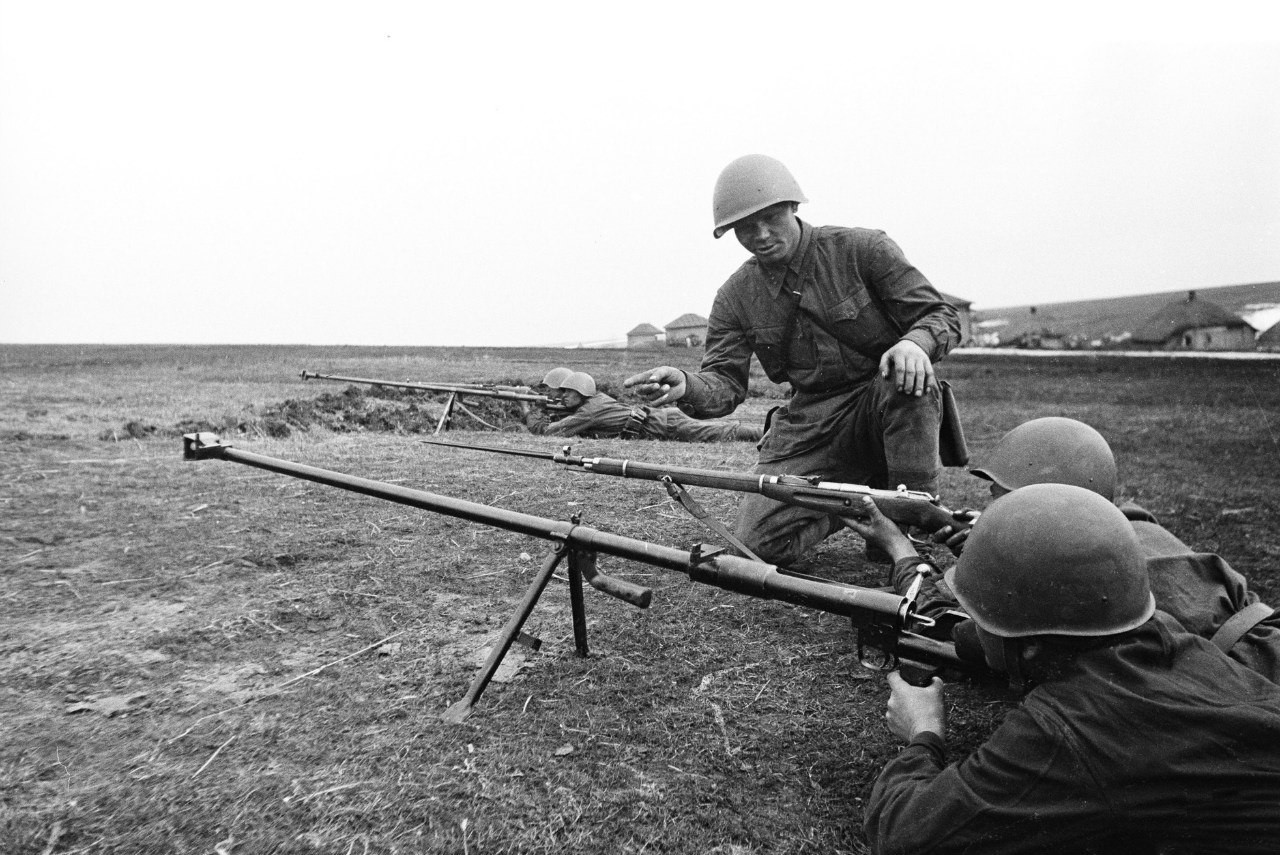 The gun was tested at the range and showed good results when shooting at the armor of German and Russian tanks. The first pre-production PTRD was manufactured and sent for testing in mid-August 1941.The gun turned out to be cheap and very technologically advanced in production, almost completely could be made on lathes, so the mass production of PTRD was mastered earlier than mass production PTRS. Decree GKO dated August 29, 1941, the anti-tank rifle of the Degtyarev Design Bureau was put into service Red Army.
The gun was tested at the range and showed good results when shooting at the armor of German and Russian tanks. The first pre-production PTRD was manufactured and sent for testing in mid-August 1941.The gun turned out to be cheap and very technologically advanced in production, almost completely could be made on lathes, so the mass production of PTRD was mastered earlier than mass production PTRS. Decree GKO dated August 29, 1941, the anti-tank rifle of the Degtyarev Design Bureau was put into service Red Army.
Serial production of the first PTRD was launched on September 22, 1941 at Kovrov Arms Plant, in October the first installation batch was assembled – 50 guns, at the end of November 1941, the production of PTRD and PTRS also mastered Izhevsk Machine Building Plant (to which drawings, technical documentation and part of the blank parts were delivered), however, until the beginning of 1942, the total production of anti-tank rifles in Izhevsk did not exceed 20 pieces. per day
On July 1, 1942, the production of anti-tank rifles from plant No. 74 was transferred to the newly formed plant No. 622. In October 1943, the production of ATGMs was transferred from plant No. 2 to plant No. 385. The production of ATGMs ceased in March 1944. However, in December, a small batch of guns was made from the remaining stock.
| Manufacturer | II/1941 | 1942 | 1943 | 1944 | Total |
| No. 2 (Kovrov) | 16038 | 144959 | 78463 | 239460 | |
| No. 74 (Izhevsk) | 1611 | 28165 | 29776 | ||
| № 385 (Zlatoust) | 5719 | 6334 | 12053 | ||
| No. 622 (Izhevsk) | 11875 | 11875 | |||
| Total | 17649 | 184999 | 84182 | 6334 | 293164 |
**The data of the factories are indicated. In total, together with the PTRS, about 1950 rifles were not accepted by military acceptance.
| Manufacturer | 10 | 11 | 12 | Total |
| No. 2 (Kovrov) | 515 | 5010 | 10513 | 16038 |
| No. 74 (Izhevsk) | 36 | 1564 | 1600 | |
| Total | 515 | 5046 | 12077 | 17638 |
The difference of 11 units is explained by the fact that these ATGMs were produced as crash guns (for ballistic research), and in total, Plant No. 74 made 25 such guns until August 1942. In addition, in 1942, 130 training ATGMs were produced there. Of the 248,782 PTRD and PTRS adopted in 1942, 114,370 were delivered in the first half of the year.
In order to improve the manufacturability of production and simplify the repair of anti-tank rifles, at the beginning of 1944, the Main Artillery Directorate of the Red Army set the task of unifying the bipods of the PTRD and PTRS.
PTRD Combat use
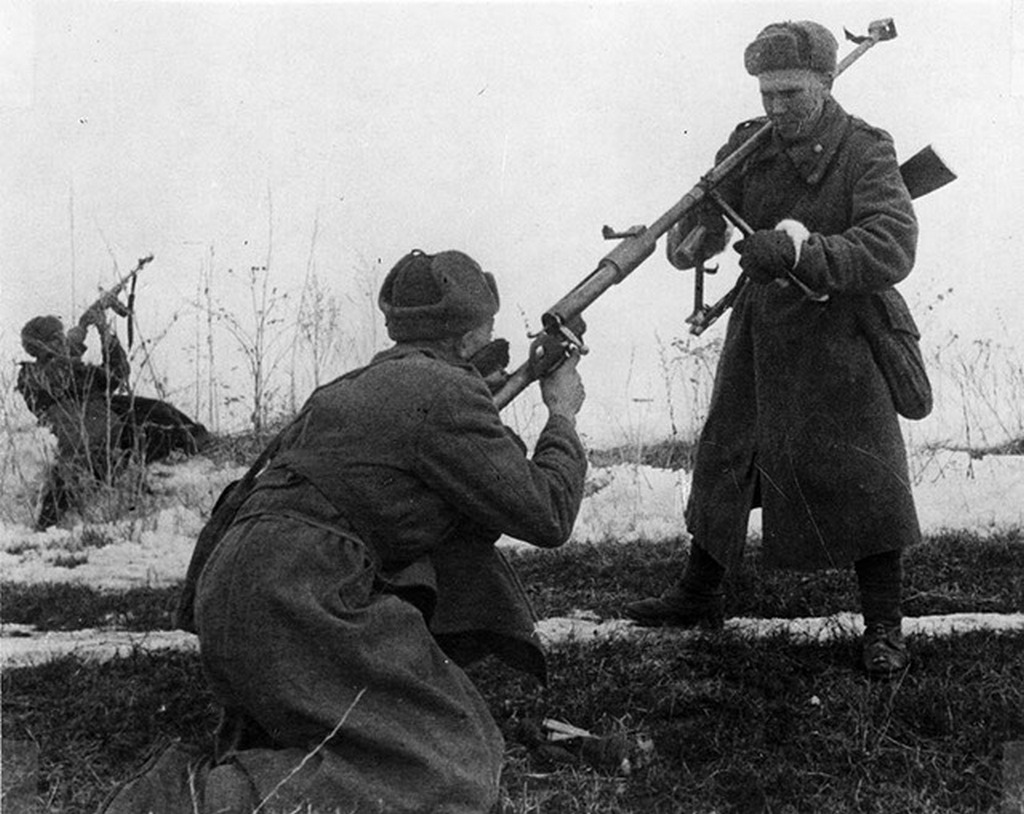 The first 300 PTRD in accordance with the directive of the commander Western Front army general G. K. Zhukova dated October 26, 1941, directly from the Kovrov plant, they were sent to 16th Army major general K. K. Rokossovsky, which defended the defensive lines in the Volokolamsk direction north-west of Moscow. Soldiers of the 1075th Infantry Regiment were the first to use the PTRD in combat. 316th Rifle Division of the Red Army.
The first 300 PTRD in accordance with the directive of the commander Western Front army general G. K. Zhukova dated October 26, 1941, directly from the Kovrov plant, they were sent to 16th Army major general K. K. Rokossovsky, which defended the defensive lines in the Volokolamsk direction north-west of Moscow. Soldiers of the 1075th Infantry Regiment were the first to use the PTRD in combat. 316th Rifle Division of the Red Army.
On November 16, 1941, the head of the artillery of the Western Front, General I.P. Camera, reported that two enemy tanks were hit by fire from anti-tank rifles in the Petelino and Shiryaevo area, and four more in the battle for Lugovaya station.
At the beginning of 1943 in the USSR under the program lend-lease the first American medium tanks were delivered M4A2 “Sherman”, during the tests of which it was found that as a result of shelling the sides of the M4A2 tank from the PTRD with cartridges with a BS-41 bullet (which had a tungsten core), the tank’s armor can be pierced at distances of 100-500 meters (depending on the location of the bullet and the angle of impact with the obstacle ). The test results caused the suspension of the delivery of tanks of the M4A2 model to the USSR in the spring – summer of 1943, and the following Sherman tanks, which were accepted by Soviet representatives at the end of November 1943, already had enhanced armor protection.
German military experts noted that the 14.5-mm PTR caused significant trouble not only for Wehrmacht light armored vehicles, but also for tanks – to protect the undercarriage from shots from PTR, additional armor plates had to be hung on the sides of German tanks and self-propelled guns.
To move the PTR in deep snow, a ski installation was used, the author of which was an ordinary 3rd Shock Army Livanyuk (installation was highly appreciated by specialists of the Main Artillery Directorate of the Red Army and was recommended for use in the troops).
In the spring of 1944, in the 5th Guards Motorized Rifle Brigade of the Red Army, a device was developed for installing anti-tank rifles on a car, which made it possible to fire on the move. After the successful completion of field tests, the device was approved for use in the army.
During the war, anti-tank rifles were used as a means of strengthening air defense, for firing at aircraft. When equipping shooting positions for firing at air targets, a wooden device like a slingshot was installed on the parapet of the trench, which served as a stop for the PTR barrel. In some cases, when arranging a position for firing at aircraft at a distance from the front line, a cart axle or a pole with a cart wheel of a suitable height was dug into the ground as a stop for the PTR barrel – the rotation of the wheel made it possible to point the PTR barrel horizontally. A significant contribution to the methods of firing from anti-tank missiles at aircraft was made by an armor-piercing gunner 284th Rifle Division of the Red Army Dmitry Shumakov, who was trained as a sniper during the Battle of Stalingrad – he drew up schemes for firing from anti-tank missiles at aircraft, which the rest of the armor-piercers of the 284th rifle division began to use first, and then other units.
By the end of the war, in 1945, in the rifle division of the Red Army, there were 111 units in the state. anti-tank rifles.
After the end of the Great Patriotic War, the ATGMs were removed from service with the Soviet Army, but remained in storage. In the mid-1950s – 1960s, a certain number of PTRDs in storage were transferred free of charge from the warehouses of the mobilization reserve of the USSR Ministry of Defense to the hunting farms of the Far North, they were used for whale hunting.
In the units of the army of the DPRK during Korean War PTRDs were used not only for firing at armored vehicles and other ground targets, but also for firing at low-flying enemy aircraft.
PTRD Characteristics
Normal combat requirements for PTRD:
three or four holes out of four fit into a circle with a diameter of 22 cm;
the mid-point of impact deviates from the control point by no more than 7 cm vertically and no more than 5 cm horizontally.
The battle is checked by firing single shots at a black rectangle 30 cm high and 20 cm wide, mounted on a white shield 1 m high and 1 m wide. Firing range – 100 m, position – lying from a bipod, cartridges – B-32.
PTRD Armor penetration, mm:
at 300 m — 35,
at 100 m — 40.
Indicators of dispersion of bullets when firing from a ATGM brought to normal combat:
| Firing range, m | Core stripes in height, cm | Core bands in width, cm |
| 100 | 21 | |
| 200 | 42 | 36 |
| 300 | 63 | 55 |
| 400 | 84 | 73 |
| 500 | 105 | 92 |
Where the core band is a scattering band containing 70% of hits.
Construction
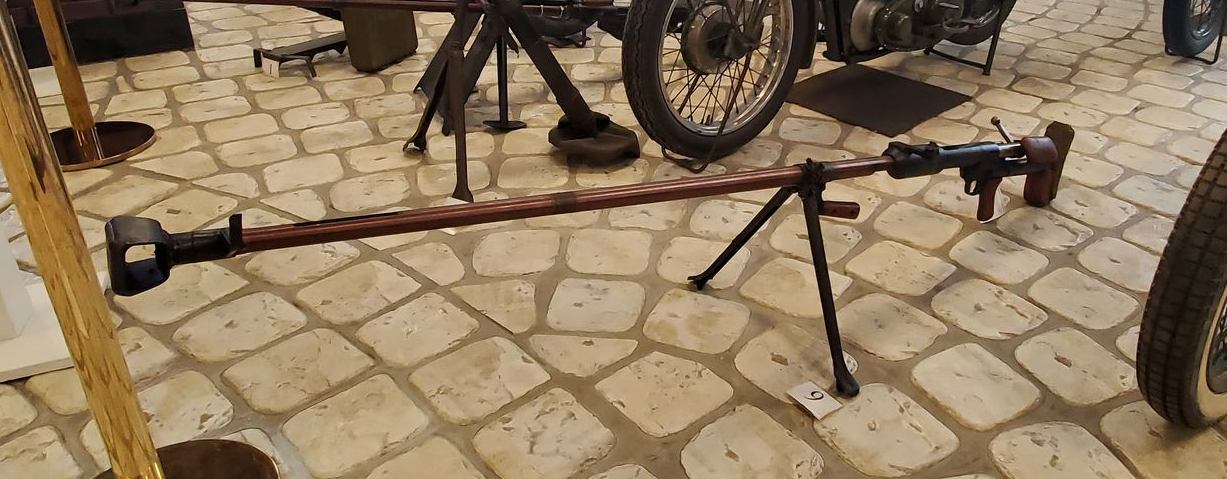 The barrel has a channel with eight rifling, winding from left to right, a muzzle brake to reduce recoil, in the middle there is a handle for carrying weapons and a groove for attaching bipods. In the front of the barrel there is a front sight base (on which the front sight is planted), and in the back there is a sight bracket.
The barrel has a channel with eight rifling, winding from left to right, a muzzle brake to reduce recoil, in the middle there is a handle for carrying weapons and a groove for attaching bipods. In the front of the barrel there is a front sight base (on which the front sight is planted), and in the back there is a sight bracket.
On the left side of the receiver is a slide delay, and below is a trigger mechanism. Outside, the receiver has: an upper window (for inserting a cartridge), a lower window (for ejecting a spent cartridge case), a ledge platform (for connecting with a butt), a cutout (for moving the bolt handle when locking and unlocking the bore). Inside the receiver has: a channel for placing the shutter, two longitudinal grooves and two support ledges.
The trigger mechanism consists of a trigger, trigger, sear and two springs (for sear and trigger).
The sight consists of a bracket, a rear sight with a slot and a spring. In early examples, the bracket has a hole through which the rear sight moves up and down. In the lower position, the rear sight corresponds to firing distances up to 400 m, and in the upper position – from 400 m to 1000 m. m.
The front sight is pushed into the groove of the front sight base and can move left and right when bringing the ATGM to normal combat.
The shutter consists of a shutter core and a percussion mechanism. The shutter frame has: a handle, a cup with a whisk (to place the cartridge head), a channel (for the passage of the firing pin), a groove (for placing the ejector), a socket (for the reflector and its spring), two lugs (for locking the barrel), beveled a cutout (retracting the drummer when the bolt opens), an annular groove (which includes an annular protrusion of the coupling for engaging the impact mechanism with the bolt frame) and two holes (removing powder gases in case they break through into the bolt). The impact mechanism consists of a striker (having a protrusion with a cocking), a coupling (connecting the impact mechanism to the bolt), a mainspring (sending the striker to the forward position), a restrictive tube (limiting the striker’s retreat back), a striker coupling (protecting the striker from disengaging from drummer) and the striker (breaking the primer).
The stock is attached to the receiver and consists of a shoulder rest (cushion) with an outer tube and a trigger box with an inner tube. The shock absorber spring is located in the outer tube, and on the left there is an emphasis for the gunner’s cheek. On the right there is a tide with a curved edge to open the shutter after the shot. A wooden stop is attached to the pillow and the outer tube for holding with the left hand during firing. In the trigger box with an inner tube is the trigger mechanism. A pistol grip is attached to the inner tube for ease of shooting. The trigger box has a platform for connecting the butt to the receiver, a hole for a pin (securing the trigger box with the receiver) and a trigger guard (protecting against accidental pressing of the trigger).
Belonging to the PTRD: a composite ramrod, a key, a screwdriver, a double-necked oiler and a brush. Also, for each gun there are two canvas cartridge bags (for 20 rounds each), two canvas covers (for the breech and muzzle of the gun) and a form (with the results of checking the battle, the number of shots, delays and ways to eliminate them).
Ammunition
Cartridges BS-41 equipped in the store PTRS
Main article: 14.5×114mm
For firing from the PTRD, 14.5 × 114 mm cartridges of the following samples are used:
B-32 – a cartridge with an armor-piercing incendiary bullet with a steel core;
BS-41 – a cartridge with an armor-piercing incendiary bullet BS-41 with a ceramic-metal core (Wolfram carbide).
Operating countries
USSR
Nazi Germany – captured ATGMs were used by the Wehrmacht under the nameAnti-tank rifle 783(r).
Czechoslovakia – in service 1st Czechoslovak Army Corps.
Poland – in 1943, the PTRD received the 1st Polish anti-tank company 1st Polish Infantry Division named after T. Kosciuszko, and later other Polish units.
Bulgaria – in 1944-1945. The USSR handed over 300 anti-tank rifles to the Bulgarian army (PTRD and PTRS), which were used during the fighting.
China
DPRK ATGMs were supplied to North Korea during Wars in Korea.
PTRD in culture
There are references to the PTRD and its application in many works: including literary and artistic works, films, cartoons and computer games.


